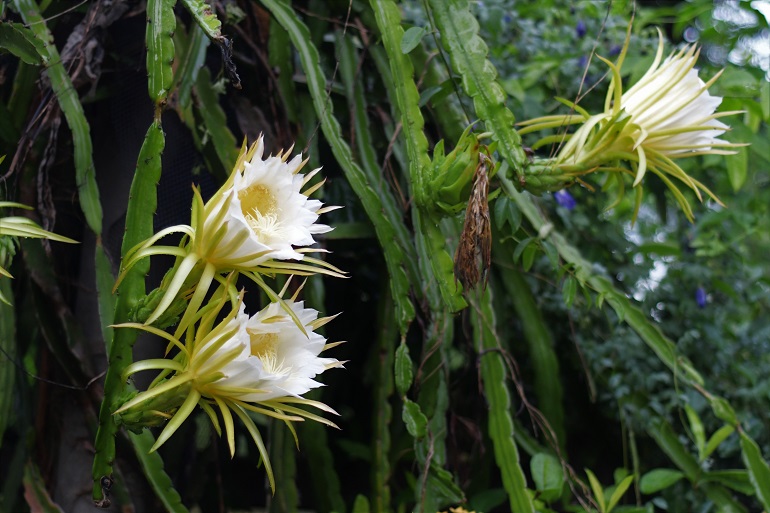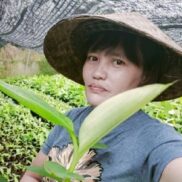Dragon Fruit Pollination and Propagation

This post is also available in:
This post is also available in:
![]() Español (Spanish)
Español (Spanish) ![]() Français (French)
Français (French) ![]() हिन्दी (Hindi)
हिन्दी (Hindi) ![]() العربية (Arabic)
العربية (Arabic) ![]() 简体中文 (Chinese (Simplified))
简体中文 (Chinese (Simplified)) ![]() Português (Portuguese (Brazil))
Português (Portuguese (Brazil))
Dragon Fruit Pollination
Pollination is essential in fruit production of the Dragon fruit. Especially for the self-incompatible varieties, cross-pollination between different dragon fruit varieties is needed to ensure a better fruit set and size. To increase plants’ potential for fruit production, farmers are advised to plant 2 to 3 different varieties (not the same clone).
As Dragon fruit is a “lady of the night”, with the flowers to open during dark hours, moths, hawks, and bats in the species range pollinate the flowers. On some cultivars, the flowers remain open during early to mid-morning hours, and it is believed that bees might visit them, as well. In most countries where this exotic fruit is grown as a new crop, they encounter poor pollination due to a lack of natural pollinators. However, hand pollination is an efficient alternative, and it is even suggested that this procedure can help increase fruit set. This may be done during the night and early morning hours by collecting pollen from one flower and applying it to the other flower’s stigma.
List of Self-Pollinating Dragon Fruit Varieties
- American Beauty
- Dark Star
- Delight
- Florida Red
- Giant Vietnamese
- Hailey’s Conet
- Makisupa
- Rixford
- Seoul Kitchen
- Surinam Red
- Thai Dragon
- Thomson
- Vietnamese White
- Voodoo Child
- Wiangel
- Condor
- Natural Mystic
- Purple Haze
The recommended variety that produces a lot of pollen and is categorized as one of the self-pollinating dragon fruit is Vietnamese White.
Propagation of Dragon Fruit
Pitaya can be propagated from seed or vegetative propagation. In seed propagation, we collect seeds from handpicked fruits from mother plants, wash them well with water, and germinate them on wet blotting papers or a sand-clay mixture. Germination starts in 3-4 days, and it will be ready for transfer to potting after 4-5 weeks. (5) This propagation procedure is very simple; however generally not recommended for commercial multiplication of dragon fruit since there were studies that it was carried out that seedlings remain smaller with thin stems even after one year of planting.
The easiest and cheapest procedure for propagating Dragon fruit is vegetative propagation, which is done by cuttings. Commonly the length of the stem that is used for planting has 20-25 cm (7.9-10 inches) size. The cutting must be ready 1 to 2 days before planting, and the latex must be dry enough. This allows the cut end to seal. The cutting must be taken from elite mother plants right after the fruiting season. To prevention of taking or spreading the diseases, the cutting should be treated with fungicides. The planting for the cutting should be 12×30 cm (4.7-11.8 in.) size polyethylene bags filled with soil, farmyard manure, and sand. This comes from a ratio of 1:1:1. The planted cuttings are kept in a shady place for rooting and to avoid excess moisture to prevent from rotting. It takes 5-6 months for the cuttings to be ready for planting.
Vegetative propagation by grafting can also be done to dragon fruit. Though this is not common practice, it is an easy and convenient propagation method. To effectively use this method, it is suggested to use only selected rootstocks and scions.
References:
- https://edis.ifas.ufl.edu/publication/HS303
- http://apps.worldagroforestry.org/downloads/Publications/PDFS/BC07324.pdf
- https://www.seedsdelmundo.com/blog/self-pollinating-dragon-fruit-varieties/
- http://apps.worldagroforestry.org/downloads/Publications/PDFS/BC07324.pdf
- https://krishi.icar.gov.in/jspui/bitstream/123456789/23809/1/Dr.Karunkaran,%20vetnum%20proceeding%20.pdf
- http://apps.worldagroforestry.org/downloads/Publications/PDFS/BC07324.pdf
- https://krishi.icar.gov.in/jspui/bitstream/123456789/23809/1/Dr.Karunkaran,%20vetnum%20proceeding%20.pdf
- http://apps.worldagroforestry.org/downloads/Publications/PDFS/BC07324.pdf
Dragon Fruit: Crop History, Nutritional Value and Uses
Dragon Fruit Plant Information and Environmental Requirements
Dragon Fruit Variety Selection
Soil Requirement and Land Preparation for Dragon Fruit
Dragon Fruit Planting Distances and Trellising
Dragon Fruit Pollination and Propagation
Dragon Fruit tree Training and Pruning
Dragon Fruit Water Requirement and Irrigation Systems








































































